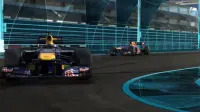Saft supplying five Formula 1 KERS cars with VL li-ion batteries [w/video]

Saft has revealed that it will supply its “state-of-the-art” batteries based on its VL lithium-ion cells to five of the 12 Formula 1 (F1) teams competing this season, including Ferrari and Lotus Renault GP. The batteries are a vital part of the Kinetic Energy Recovery System (KERS) that is being deployed in response to regulations that encourage the development and use of energy-saving technology in F1.
When a KERS-equipped F1 racecar brakes, a portion of its kinetic energy is captured and converted into electrical energy, which is stored in the VL li-ion cells. When extra power is needed, the battery pack releases the stored energy. The Saft setup provides 60 kW (approximately 80 horsepower) of boost, which the driver can use for up to seven seconds each lap. Saft has worked closely to develop tailor-made solutions for each team’s unique KERS system. The battery maker says that its VL li-ion cells offer the “optimum combination of performance, power-to-weight ratio, reliability and safety.”
Click past the jump for Red Bull’s Sebastian Vettel’s explanation of the benefits of KERS. Hint: it makes things faster.
[Source: Saft]
· KERS hybrid technology stores energy during braking and converts it into extra
power for overtaking and quicker laptime
· Saft’s high technology VL Li-ion cells provide the optimum combination of performance,
power-to-weight ratio and long cycle life for five of the twelve teams competing this season
Paris, April 11, 2011 – Saft, the world specialist in the design and manufacture of high-tech
batteries for industry, has developed state-of-the-art lithium-ion (Li-ion) batteries that will be
providing a boost to five of the twelve Formula 1 teams competing this season, including Ferrari
and Lotus Renault GP.
Saft’s Li-ion batteries are at the heart of the Kinetic Energy Recovery System (KERS) that will be
deployed by the five teams in response to the FIA regulations that encourage the development
of energy-saving technology. KERS also promotes more exciting racing by providing a power
boost for overtaking.
“Our solutions for KERS demonstrate Saft’s ability to deliver leading-edge technology for the
most complex and demanding high performance applications, even while working to extremely
tight deadlines,” says Xavier Delacroix, General Manager of Saft’s IBG division. “We are aiming
to establish our Li-ion batteries as the reference for Formula 1.”
KERS performance with Li-ion
The Saft Li-ion battery allows up to 60 kW boost (around 80 horsepower), with an energy
release up to 400 kJ per lap. The driver can use this additional power to provide an extra seven second boost of acceleration in each lap.
When the F1 car brakes, a proportion of its kinetic energy is captured by an electric
motor/generator (MGU) connected mechanically to the engine. This captured kinetic energy is
converted into electrical energy which is stored in the Saft Li-ion cells. When extra power is
needed, the battery releases the stored energy to the MGU which functions as an electric motor,
providing extra power to the drive train.
KERS battery considerations
The F1 KERS is a particularly demanding battery application. Saft has worked closely with the
F1 teams to develop tailor-made solutions for each team’s KERS design, based on its high technology VL Li-ion cells – which offered the optimum combination of performance, power-to weight ratio, reliability and safety. Lifetime and durability are also key considerations since the
batteries are subjected to high levels of heat and vibration.




